Climate change is a complicated problem that requires complicated solutions. Whether we’re talking about reducing our current output of greenhouse gas emissions or finding ways to recapture greenhouse gases, the methods and technologies required to do so push the limits of human innovation.
The latest example of this comes from ETH Zurich, where an interdisciplinary research team has been working on combining conventional building materials with living organisms, such as bacteria, algae, and fungi. Now, led by Mark Tibbitt, professor of macromolecular engineering, the researches have successfully incorporated cyanobacteria into a printable hydrogel to create a material that lives, grows, and actively removes carbon dioxide from the air.
Requiring only sunlight and artificial seawater containing essential nutrients, the material is capable of absorbing more CO2 than it binds through organic growth. “This is because the material can store carbon not only in biomass, but also in the form of minerals – a special property of these cyanobacteria,” Tibbitt explained in a press release. “As a building material, it could help to store CO2 directly in buildings in the future.”
In addition to generating biomass, the cyanobacteria used in the study change the chemical environment around themselves, precipitating solid carbonates, such as lime. These minerals represent an additional carbon sink and – in contrast to biomass – store CO2 in a more stable form. As an added bonus, the carbonates also provide mechanical reinforcement, resulting in the structures slowly hardening over time.

According to the researchers, laboratory testing of the material showed that it continuously bound CO2 over a period of 400 days at a rate of 26 milligrams of CO2 per gram of material, more than three times the rate of chemical mineralization in recycled concrete (which is around 7 milligrams CO2 per gram).
More than a method for prototyping, 3D printing was essential in this application due to the need to produce optimized geometries to increase light penetration, surface aera, and the flow of nutrients. “In this way, we created structures that enable light penetration and passively distribute nutrient fluid throughout the body by capillary forces,” said Dalia Dranseike, a member of Tibbit’s team and co-first author on the published research.
The 3D printed designs have enabled the cyanobacteria to live productively for more than a year, according to the researchers. While it may one day be possible to build entire structures using this material, the next step, according to Tibbitt, is to apply it as a coating on building facades. As a proof-of-concept, two installations have been created with the material at the Architecture Biennale in Venice and the Triennale di Milano in Milan.
The research is published in the journal Nature Communications.
The post 3D printed building material actively removes CO2 from the air appeared first on Engineering.com.

